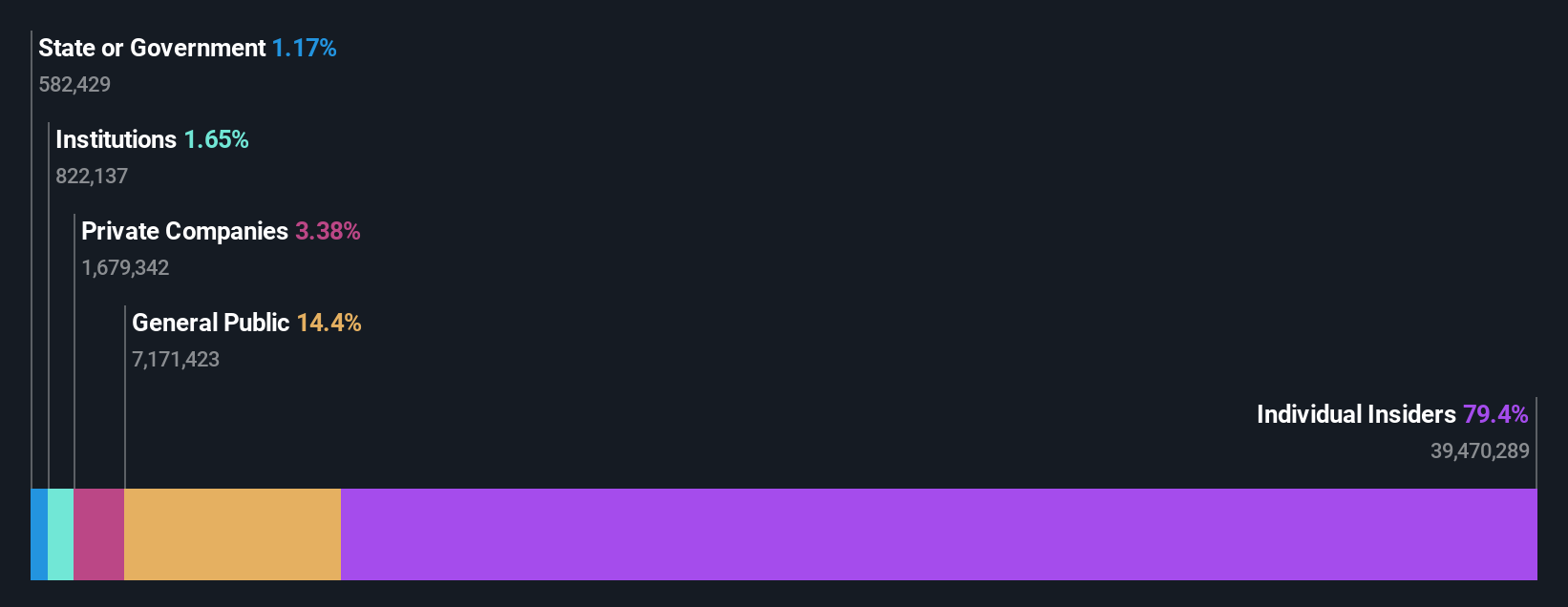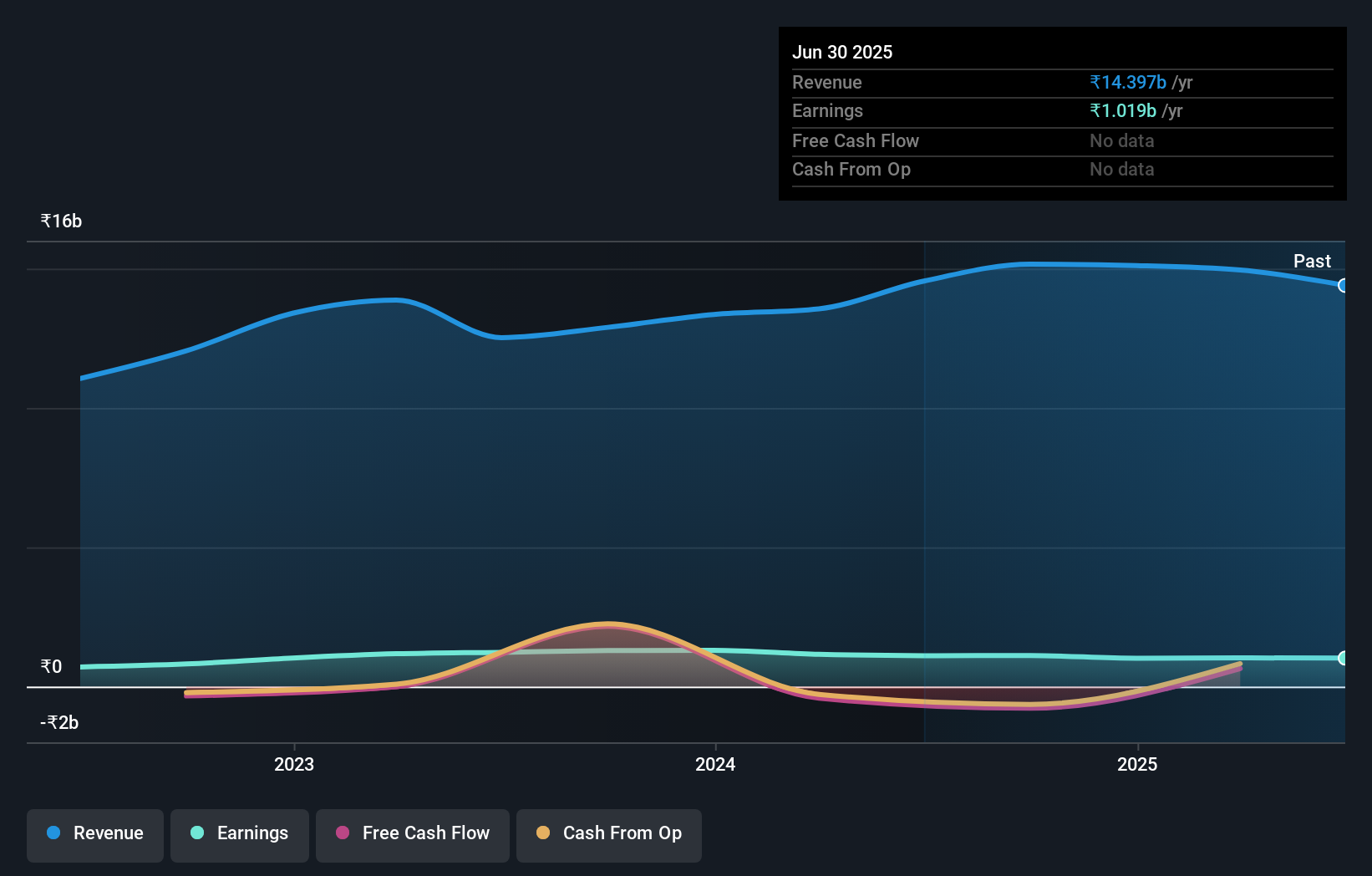Chaman Lal Setia Exports Ltd.'s (NSE:CLSEL) most bullish insider is Co-Chief Executive Officer Rajeev Setia, and their holdings value went up by 11% last week
Key Insights
- Significant insider control over Chaman Lal Setia Exports implies vested interests in company growth
- The top 2 shareholders own 72% of the company
- Ownership research, combined with past performance data can help provide a good understanding of opportunities in a stock
If you want to know who really controls Chaman Lal Setia Exports Ltd. (NSE:CLSEL), then you'll have to look at the makeup of its share registry. And the group that holds the biggest piece of the pie are individual insiders with 79% ownership. That is, the group stands to benefit the most if the stock rises (or lose the most if there is a downturn).
Clearly, insiders benefitted the most after the company's market cap rose by ₹1.4b last week.
Let's take a closer look to see what the different types of shareholders can tell us about Chaman Lal Setia Exports.
Check out our latest analysis for Chaman Lal Setia Exports

What Does The Institutional Ownership Tell Us About Chaman Lal Setia Exports?
Institutional investors commonly compare their own returns to the returns of a commonly followed index. So they generally do consider buying larger companies that are included in the relevant benchmark index.
Since institutions own only a small portion of Chaman Lal Setia Exports, many may not have spent much time considering the stock. But it's clear that some have; and they liked it enough to buy in. If the company is growing earnings, that may indicate that it is just beginning to catch the attention of these deep-pocketed investors. We sometimes see a rising share price when a few big institutions want to buy a certain stock at the same time. The history of earnings and revenue, which you can see below, could be helpful in considering if more institutional investors will want the stock. Of course, there are plenty of other factors to consider, too.

We note that hedge funds don't have a meaningful investment in Chaman Lal Setia Exports. Because actions speak louder than words, we consider it a good sign when insiders own a significant stake in a company. In Chaman Lal Setia Exports' case, its Co-Chief Executive Officer, Rajeev Setia, is the largest shareholder, holding 37% of shares outstanding. In comparison, the second and third largest shareholders hold about 35% and 2.3% of the stock. Interestingly, the second-largest shareholder, Vijay Setia is also Co-Chief Executive Officer, again, pointing towards strong insider ownership amongst the company's top shareholders.
To make our study more interesting, we found that the top 2 shareholders have a majority ownership in the company, meaning that they are powerful enough to influence the decisions of the company.
While it makes sense to study institutional ownership data for a company, it also makes sense to study analyst sentiments to know which way the wind is blowing. We're not picking up on any analyst coverage of the stock at the moment, so the company is unlikely to be widely held.
Insider Ownership Of Chaman Lal Setia Exports
The definition of an insider can differ slightly between different countries, but members of the board of directors always count. Management ultimately answers to the board. However, it is not uncommon for managers to be executive board members, especially if they are a founder or the CEO.
Insider ownership is positive when it signals leadership are thinking like the true owners of the company. However, high insider ownership can also give immense power to a small group within the company. This can be negative in some circumstances.
Our information suggests that insiders own more than half of Chaman Lal Setia Exports Ltd.. This gives them effective control of the company. So they have a ₹11b stake in this ₹14b business. It is good to see this level of investment. You can check here to see if those insiders have been buying recently.
General Public Ownership
With a 14% ownership, the general public, mostly comprising of individual investors, have some degree of sway over Chaman Lal Setia Exports. While this size of ownership may not be enough to sway a policy decision in their favour, they can still make a collective impact on company policies.
Private Company Ownership
Our data indicates that Private Companies hold 3.4%, of the company's shares. It's hard to draw any conclusions from this fact alone, so its worth looking into who owns those private companies. Sometimes insiders or other related parties have an interest in shares in a public company through a separate private company.
Next Steps:
It's always worth thinking about the different groups who own shares in a company. But to understand Chaman Lal Setia Exports better, we need to consider many other factors. For instance, we've identified 1 warning sign for Chaman Lal Setia Exports that you should be aware of.
If you would prefer check out another company -- one with potentially superior financials -- then do not miss this free list of interesting companies, backed by strong financial data.
NB: Figures in this article are calculated using data from the last twelve months, which refer to the 12-month period ending on the last date of the month the financial statement is dated. This may not be consistent with full year annual report figures.
New: AI Stock Screener & Alerts
Our new AI Stock Screener scans the market every day to uncover opportunities.
• Dividend Powerhouses (3%+ Yield)
• Undervalued Small Caps with Insider Buying
• High growth Tech and AI Companies
Or build your own from over 50 metrics.
Have feedback on this article? Concerned about the content? Get in touch with us directly. Alternatively, email editorial-team (at) simplywallst.com.
This article by Simply Wall St is general in nature. We provide commentary based on historical data and analyst forecasts only using an unbiased methodology and our articles are not intended to be financial advice. It does not constitute a recommendation to buy or sell any stock, and does not take account of your objectives, or your financial situation. We aim to bring you long-term focused analysis driven by fundamental data. Note that our analysis may not factor in the latest price-sensitive company announcements or qualitative material. Simply Wall St has no position in any stocks mentioned.
About NSEI:CLSEL
Chaman Lal Setia Exports
Manufactures, trades, and markets rice in India.
Flawless balance sheet average dividend payer.
Similar Companies
Market Insights
Community Narratives



